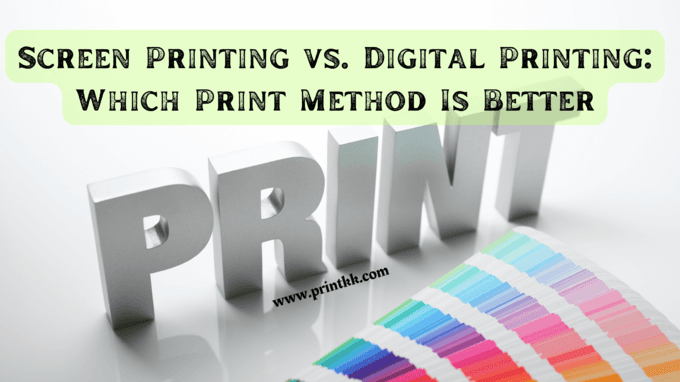3 Easy Facts About Tx Tees Explained
3 Easy Facts About Tx Tees Explained
Blog Article
The Buzz on Tx Tees
Table of ContentsNot known Factual Statements About Tx Tees The 45-Second Trick For Tx TeesThe 10-Minute Rule for Tx TeesA Biased View of Tx TeesExcitement About Tx TeesIndicators on Tx Tees You Should KnowThe Facts About Tx Tees Uncovered
Include up various other expenses, like the number of utilities it takes to run the shop and the expense of ink and emulsion per layout. Take the print listed below.The solution must only be a couple of cents considering that you 'd just require to layer one display for this task. How much should you bill per shirt to make an earnings? Typically, printers try to make up to 45% profit on a print job. Right here's a table to help you determine that: total price per item percent of desired earnings as a decimal (example:.25 or.45) revenue made per product per work Currently let's discuss the productivity of DTF.

With DTF, you can publish a handful of tee shirts, or simply one. Both display printing and DTF have their niches in the globe.
The Tx Tees Ideas
The most effective way to understand? Ask about and see what printing shop like your own are doing. custom screen printing. Attempt both out and see which you like far better
When you're choosing what sort of printing method to make use of for printing your artwork designs on your garments, it is very important that you know the differences between these two strategies so you can make best use of outcomes while decreasing costs. Display printing is the most commonly made use of technique for publishing designs on textiles.
DTG printing is also recognized as spot or straight to garment printing since it publishes only what is needed rather than making a screen as display printers do. https://nowewyrazy.uw.edu.pl/profil/txtees02. Screen printing works by display filler squeegee screen printing ink display mesh display, after that transferring the image to garment making use of warm and/or stress
The DTG printer makes use of special dye-sublimation inks that are applied into a pre-designed picture by an electronic printing system. The inks enter into the textile, enabling vivid colors and exceptional information. It's likewise called area or direct to garment printing due to the fact that it publishes just what is needed rather than making a display as screen printers do.
About Tx Tees
It's much faster - you can print a fullcolor photo in minutes, as opposed to hours for screen printing. Second, there's no established time or expenses involved - you can print any type of design you like, without needing to produce a screen initially. Third, there's no waste - because screen printers display print one style each time, they have to evaluate each shade independently.
The paper is very pricey and can only be made use of once. Once it's published on, it needs to be discarded. - The first acquisition cost is less than the ahead of time financial investment of DTG printers- You can publish multi-color layouts one screen each time rather than having to publish each shade separately like DTG printing.

The Ultimate Guide To Tx Tees
Instead of using screen mesh as display printers do, dye sublimation printers make use of laser modern technology to transfer your photos onto garments or paper. A heat procedure transfers the color from its solid-state directly into the gas phase which in turn merges it onto fabric substrates when they are swiftly heated up to heats under high pressure.
Sublimation printing is eco-friendly. It makes use of less water than screenprinting, and because it doesn't involve the use of damaging solvents, it's safe for all sorts of clothing. The dye my review here sublimation inks are additionally odor free when treated, unlike screen printers that make use of harmful chemicals throughout the display printing process that leave an unpleasant odor.
They likewise conserve cash on expensive devices like exposure devices given that dye sublimation printers don't call for a UV direct exposure unit or a flash remedy oven that is normally used in display printing (t-shirt printing). What is straight to garment printing (DTG Printing)? DTG printing is a digital screenprinting procedure that prints directly onto material using specialized inkjet printers
Indicators on Tx Tees You Should Know
DTG printing supplies numerous advantages over conventional screenprinting, consisting of the capability to publish photo quality photos, better shade vibrancy, and the capability to print styles on darker fabrics. DTG printers work by heating up the textile ink till it becomes a gas. The gas after that permeates the textile, bonding with the fibers to produce a permanent print.

Display printers simply prepare their display then start publishing till they lack item or ink.- There is a vast array of knowledgeable screen printers all over the world, which can be handy for novices. - It's a slower procedure - display printers frequently have to await the ink to dry prior to they can publish the following shade- Display printers need hands-on labor, so there's a greater discovering contour and it takes longer to create a high-quality layout- Display printing isn't as precise as DTG printing, so you may obtain some "bleeding" of colors from one component of the picture onto an additional if not done properly.
Getting The Tx Tees To Work
However, as opposed to using display mesh as screen printers do, color sublimation printers utilize laser technology to move your pictures onto garments or paper. A heat process moves the color from its solid-state straight into the gas stage which consequently integrates it onto material substratums when they are rapidly heated up to high temperatures under high stress.
Sublimation printing is green. It utilizes less water than screenprinting, and because it does not entail the use of damaging solvents, it's secure for all kinds of garments. The dye sublimation inks are additionally odorless when cured, unlike screen printers that utilize damaging chemicals throughout the screen printing process that leave an undesirable odor.
They likewise conserve money on costly equipment like exposure units because color sublimation printers do not call for a UV exposure device or a flash cure stove that is typically made use of in screen printing. What is straight to garment printing (DTG Printing)? DTG printing is a digital screenprinting procedure that publishes directly onto material utilizing specialized inkjet printers.
The Ultimate Guide To Tx Tees
DTG printing offers numerous benefits over traditional screenprinting, including the capacity to publish photo top quality images, better color vibrancy, and the ability to publish designs on darker fabrics. DTG printers work by heating up the textile ink up until it develops into a gas. The gas after that penetrates the textile, bonding with the fibers to produce an irreversible print.
Report this page